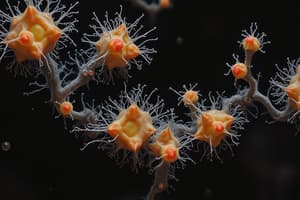Podcast
Questions and Answers
Which of the following types of microorganisms is studied in microbiology?
Which of the following types of microorganisms is studied in microbiology?
- Bacteria
- Viruses
- Fungi
- All of the above (correct)
Antonie van Leeuwenhoek was the first to observe microorganisms through a microscope.
Antonie van Leeuwenhoek was the first to observe microorganisms through a microscope.
True (A)
What is the study of fungi called?
What is the study of fungi called?
Mycology
Microorganisms are essential in the production of foods such as ______ and wine.
Microorganisms are essential in the production of foods such as ______ and wine.
Match the following subfields of microbiology with their focus:
Match the following subfields of microbiology with their focus:
Which scientist is known for disproving the theory of spontaneous generation?
Which scientist is known for disproving the theory of spontaneous generation?
Microbial infections only affect humans.
Microbial infections only affect humans.
What crucial role do microorganisms play in the environment?
What crucial role do microorganisms play in the environment?
Which type of microorganism can thrive in extreme environments?
Which type of microorganism can thrive in extreme environments?
Bacteria have a defined nucleus.
Bacteria have a defined nucleus.
What do methanogens produce as a metabolic byproduct?
What do methanogens produce as a metabolic byproduct?
The bacterium ________ is commonly found in the intestines and can cause food poisoning.
The bacterium ________ is commonly found in the intestines and can cause food poisoning.
Match the following microorganisms with their characteristics:
Match the following microorganisms with their characteristics:
Which of the following is NOT a shape of bacteria?
Which of the following is NOT a shape of bacteria?
Streptococcus pneumoniae is known for causing skin infections.
Streptococcus pneumoniae is known for causing skin infections.
What is the primary characteristic that distinguishes bacteria from archaea?
What is the primary characteristic that distinguishes bacteria from archaea?
What is the ideal temperature range to minimize bacterial growth in food?
What is the ideal temperature range to minimize bacterial growth in food?
Bacteria can double in number every 20 minutes in ideal conditions.
Bacteria can double in number every 20 minutes in ideal conditions.
What are facultative anaerobes?
What are facultative anaerobes?
Foods with high water activity (above 0.85 aw) provide an ideal environment for bacterial growth, such as fresh meats, fruits, and ________.
Foods with high water activity (above 0.85 aw) provide an ideal environment for bacterial growth, such as fresh meats, fruits, and ________.
Match the bacterial classification with its oxygen requirement:
Match the bacterial classification with its oxygen requirement:
What is the effect of freezing on bacterial growth?
What is the effect of freezing on bacterial growth?
Cooking food to the appropriate temperature can kill harmful bacteria.
Cooking food to the appropriate temperature can kill harmful bacteria.
What measures can be taken to reduce moisture content in food?
What measures can be taken to reduce moisture content in food?
Which type of thermometer provides continuous temperature monitoring while cooking?
Which type of thermometer provides continuous temperature monitoring while cooking?
Digital thermometers are not suitable for checking internal temperatures of thin foods.
Digital thermometers are not suitable for checking internal temperatures of thin foods.
What is the main advantage of using Instant-Read Thermometers?
What is the main advantage of using Instant-Read Thermometers?
________ thermometers do not require batteries and are known for their durability.
________ thermometers do not require batteries and are known for their durability.
Match the thermometer type with its primary use or advantage:
Match the thermometer type with its primary use or advantage:
What is a major limitation of Instant-Read Thermometers?
What is a major limitation of Instant-Read Thermometers?
Infrared Thermometers can measure the internal temperature of foods.
Infrared Thermometers can measure the internal temperature of foods.
What is the main limit concerning the use of Leave-In Thermometers?
What is the main limit concerning the use of Leave-In Thermometers?
What type of microorganism is responsible for causing taeniasis?
What type of microorganism is responsible for causing taeniasis?
Prions contain nucleic acids such as DNA or RNA.
Prions contain nucleic acids such as DNA or RNA.
What are multicellular parasitic worms commonly referred to as?
What are multicellular parasitic worms commonly referred to as?
______ are bacteria that grow best at moderate temperatures, including human body temperature.
______ are bacteria that grow best at moderate temperatures, including human body temperature.
Which group of bacteria thrives in extremely hot environments?
Which group of bacteria thrives in extremely hot environments?
Acidophiles prefer environments with a neutral pH range.
Acidophiles prefer environments with a neutral pH range.
Match the following types of microorganisms with their examples:
Match the following types of microorganisms with their examples:
The optimal pH range for neutrophiles is between ______.
The optimal pH range for neutrophiles is between ______.
Flashcards are hidden until you start studying
Study Notes
Introduction to Microbiology
- Microbiology studies microorganisms, which include bacteria, archaea, fungi, algae, protozoa, and viruses.
- Microorganisms are found in diverse environments, such as deep oceans and the human body.
- Key research areas include microbial structure, function, classification, and interactions with other organisms and the environment.
- Microbes can be beneficial (e.g., in food production) or harmful (e.g., pathogens).
Importance of Microbiology
- Microorganisms are crucial for natural processes like decomposition and nutrient cycling.
- They contribute to food and beverage production, including bread, cheese, yogurt, and alcoholic beverages.
- Microbes are fundamental in creating antibiotics, vaccines, and pharmaceuticals.
- Understanding microbes is vital for managing infectious diseases.
Historical Background
- The field began in the 17th century with the microscope, notably through Antonie van Leeuwenhoek's observations.
- Key historical figures include Louis Pasteur, who disproved spontaneous generation and clarified the role of microbes in fermentation and disease.
- Robert Koch established the germ theory of disease and techniques for isolating bacteria.
Subfields of Microbiology
- Bacteriology: Focus on bacteria.
- Virology: Study of viruses.
- Mycology: Examination of fungi.
- Parasitology: Analysis of parasites, including protozoa and helminths.
- Phycology: Investigation of algae.
- Immunology: Studies the immune system and its interaction with microorganisms.
Modern Microbiology
- Advances in molecular biology have transformed the study of microorganisms, enhancing understanding of genetics, metabolism, and evolution.
- DNA sequencing techniques have uncovered new species and their environmental relationships.
- Micobiology addresses global issues like antibiotic resistance, emerging diseases, and environmental sustainability.
Types of Microorganisms
- Bacteria: Single-celled prokaryotes lacking a nucleus; come in various shapes (bacilli, cocci, spirilla).
- Archaea: Also single-celled prokaryotes, often found in extreme environments (hot springs, salt lakes). Examples include methanogens, halophiles, and thermophiles.
- Viruses: Infectious agents that require a host to replicate (e.g., Influenza virus, HIV).
- Helminths: Multicellular parasitic worms relevant to microbiology despite being visible (e.g., Taenia solium, Ascaris lumbricoides).
- Prions: Infectious proteins causing neurodegenerative diseases, lack nucleic acids (e.g., Creutzfeldt-Jakob disease).
Factors Influencing Bacterial Growth (FATTOM)
- Temperature: Optimal growth ranges differ (psychrophiles, mesophiles, thermophiles, hyperthermophiles).
- pH: Bacteria prefer specific pH levels (acidophiles, neutrophiles); ideal conditions minimize foodborne illness risks.
- Oxygen: Bacteria categorized based on oxygen needs (aerobic, anaerobic, facultative anaerobes).
- Moisture: High water activity (aw) promotes growth; drying and adding preservatives can inhibit bacteria.
- Time and Temperature Control: Critical for food safety; eliminate risks from "Danger Zone" temperatures (40°F to 140°F/4°C to 60°C).
Food Thermometers
- Dial (Analog) Thermometers: Good for large items; less precise for thin foods.
- Digital Thermometers: Quick and accurate readings; suitable for many food types.
- Instant-Read Thermometers: Provide rapid temperature checks during cooking.
- Leave-In Thermometers: Allow continuous monitoring while cooking.
- Infrared Thermometers: Measure surface temperature without contact, ideal for grilling and frying.
Studying That Suits You
Use AI to generate personalized quizzes and flashcards to suit your learning preferences.




